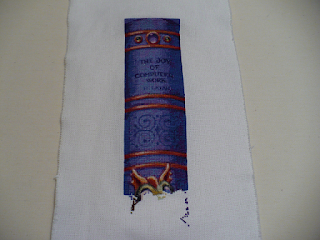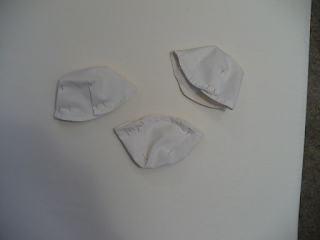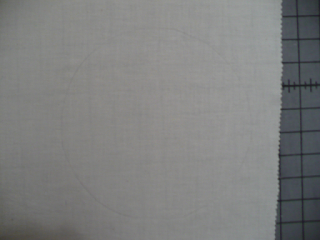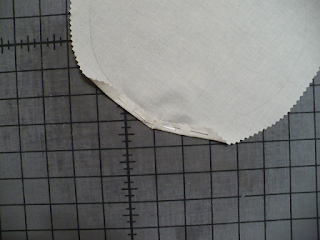As part of my ongoing quest to reduce the amount of disposable stuff that I send to the landfill, I decided to switch to a reusable coffee filter. While researching permanent coffee filters, I discovered the existence of cloth coffee filters (a fortuitous discovery, as it turns out, because I couldn't find a permanent filter that would fit my coffee maker). There are several tutorials out there on how to make the cone-shaped filters, but only vague hints on how to make the basket-shaped variety. So, I took those vague hints and made a basket-shaped filter that can be washed and reused.
A note on materials: You'll really want to use unbleached or natural muslin for these. If you use a dyed, printed, or bleached fabric, the chemicals may leach into your coffee. Also, I wouldn't bother with Kool-Aid or any other food-based dyes because the coffee will dye the filters brown. Similarly, you'll want to use plain white (or unbleached and undyed, if you can find it) 100% cotton thread. The thread needs to be cotton because polyester thread can cut through cotton fabric (muslin is cotton). I'd also recommend using a #2 pencil to mark your fabric; the chemicals in other marking tools may not be safe.
First, prewash your fabric. Don't use any bleach, fabric softener, etc., in the wash, just soap and hot water. I know some of you don't like to prewash fabric, but in this project you need to remove any sizing or other chemicals that the manufacturer may have used. Also, prewashing will shrink the fabric; it would really suck if you did all the work to make these filters just to have them shrink the first time you washed them and then not fit your coffee maker. Ironing the fabric will probably make it easier to work with, but it's not strictly necessary. These are coffee filters -- they don't have to be pretty. A few wrinkles won't matter.
Next, get a paper filter that fits your coffee maker and flatten it out. You can use the paper filter as a pattern to draw directly on the fabric, or use it to make a template. I'd recommend making a template because you're going to want to make several of these.
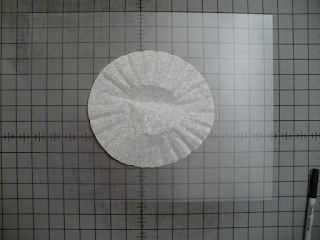
Place your flattened paper filter on a piece of cardboard or template plastic and trace around it. It doesn't have to be perfect. You can use whatever marking tool you like on the template material, but if you plan to reuse the paper filter to make coffee be sure to cut off any marks you may have accidentally made on the paper filter. You don't want to be drinking those chemicals.
Cut out your template and use it to draw a circle on your fabric with a #2 pencil. Be sure to leave enough room outside the circle to cut it out later. You won't be cutting on the line you just marked, but a little ways outside it. The following steps will make it clear how much.
Now, cut out your circle, leaving approximately twice the desired width of your hem outside the marked circle. Again, it doesn't have to be perfect. I used pinking shears to cut mine out, but you can use regular scissors.
Next, fold the edge of your fabric to your marked line and pin it in place. You're working with curves, so it won't fit exactly, but that's okay. Just do whatever folding/scrunching you need to do to make it work. Remember, we're making coffee filters here; they don't have to be pretty.
Removing one or two pins at a time, fold the edge over again and pin it in place, making certain that the raw edge of the fabric is completely covered. The idea here is to hem the edge of your circle so that it doesn't unravel. When you're done with this step, check to make sure that your circle is roughly the same size as your template. It's okay if it's a little off, but if there's a big difference it may not fit your coffee maker and you'll want to repin it.
Sew your hem in place, making sure that the raw edge is completely concealed within the hem. Remember, it doesn't have to be perfect or pretty. Don't bother pressing the hem.
Now for the fun part. Put your hemmed circle inside the filter basket for your coffee maker, do whatever origami you need to do to make it fit, and pin the folds in place. You may wish that you had a third hand at this point. I ended up using masking to tape to hold bits of it in place while I fiddled with other bits. My filters have 4 folds; yours may turn out differently depending on the shape and size of your filter basket. And remember, it doesn't have to be perfect.
Finally, once you've got your filter folded and pinned to your satisfaction, sew the folds in place and you're done.
Use your cloth filter the same way as you would a paper filter, except don't throw it away. Dump the worst of the coffee grounds in the trash or compost heap, rinse the remaining grounds out, let it dry, then put it aside until you have a bunch of filters that need to be washed. And, yes, you do need to wash these, despite what you may have read elsewhere. Seriously, have some people never heard of bacteria? Make a bunch of filters so that you can go several days between washing sessions. You can wash these by hand or in the machine, but remember to use only hot water and soap. Also, because coffee stains, you'll want to wash them separately or with stuff that you don't mind turning brown. You can put them in the dryer or hang them up to dry.












